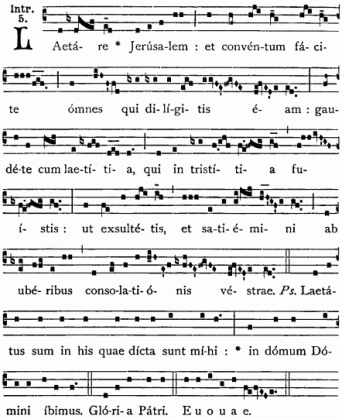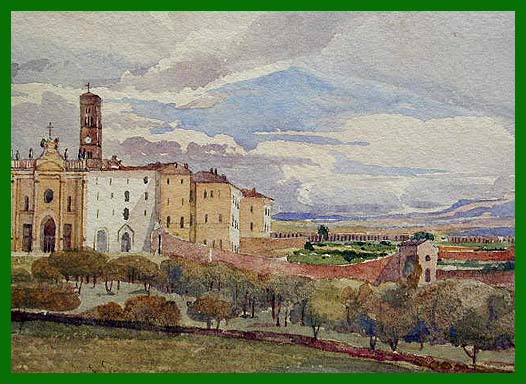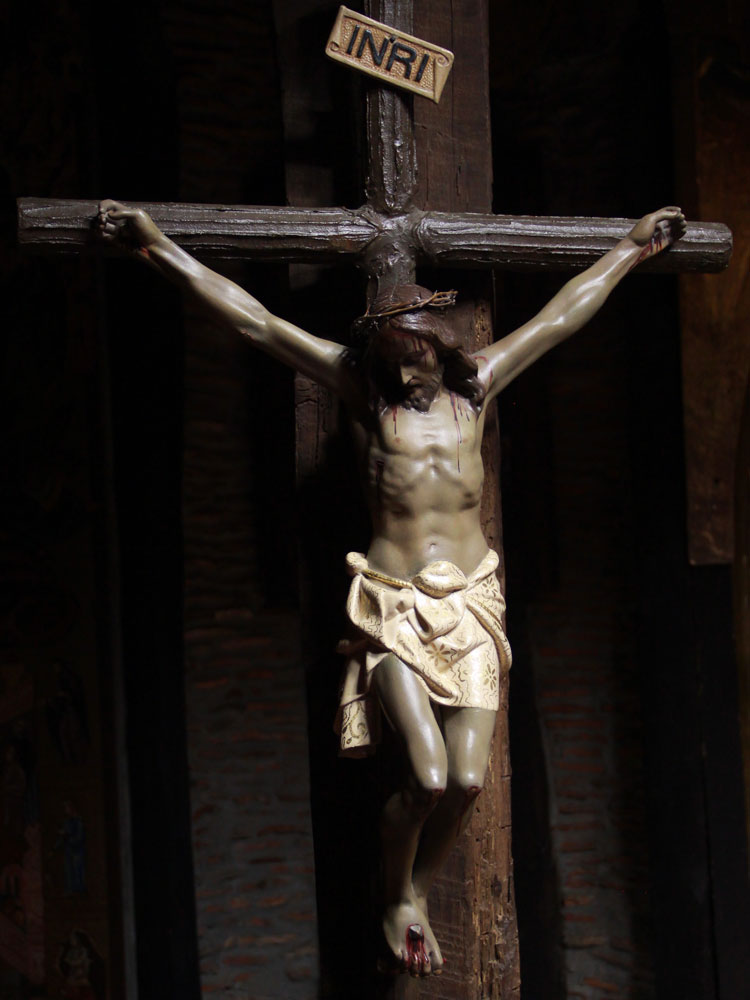Laetare, Jerusalem!
 Like a Breath of Springtide
Like a Breath of Springtide
“Be glad, Jerusalem! Hold an assembly, all you that love her: rejoice and be glad, you that were in sadness: that you may exult and be suckled plentifully with the breasts of her consolations” (Isaias 66:10-11). Listen to Dame Aemiliana Löhr’s splendid commentary on the signature antiphon of today’s Mass:
Here is a hymn of joy in the midst of the gloom of Lent. The Church has put on clothing to match it. The long-missed flowers are here in God’s house, and the dark violet of the priest’s vestments has become a gentle rose colour. . . . The first sounds of the Introit lie like a breath of springtide upon the Mass today. The text cannot find words enough for its joy, and the melody is even deeper in its rejoicing. This Laetare, once heard, is unforgettable, and anyone who knows the music of the liturgy knows why. Easter tones ring out of it. (The Mass Through the Year, p. 243)
The Hidden Alleluia
The first few notes of today’s Introit are identical with the last few notes of the great first Alleluia of the Paschal Vigil. This no mere coincidence; it reveals the underlying unity of the mystery. The Church cannot wait until the Paschal Vigil, so great is her joy already. Through the eyes of the man born blind, she looks into the face of Christ, “the light of the world” (John 9:5), and cannot contain her gladness.
She already sings the paschal alleluia but, for the moment, disguises it beneath a rosy veil. The alleluia of the Paschal Vigil is given us today wrapped in another word, a single jubilant cry: Laetare! These are mystagogical details of the sacred liturgy, too precious to be missed, too rich to be left aside. Back to Dame Aemiliana Löhr:
Today the glory of the resurrection is made present out of time, and in a single word all of the splendour of the foreplay for the feast of Easter is gathered. . . . Jerusalem! Sion! It is to Jerusalem that the call goes out. Jerusalem is the shining reason for this joy. Jerusalem, the holy city. (The Mass Through the Year, p. 243)
Jerusalem in Rome
Jerusalem is, according to the psalmist, “the dwelling of all joy” (cf. Psalm 86:7). In Rome, where the Lenten liturgy is celebrated in ancient stational churches, the Mass of Laetare Sunday is set in the Basilica of the Holy Cross in Jerusalem. In that context, the great cry, “Jerusalem!” has a special resonance. You may ask why this basilica came to be called “in Jerusalem” when, in fact, it stands in Rome. In antiquity, it was called simply, “Jerusalem.” To go to the Basilica of the Holy Cross was to go “up to Jerusalem.”
When, in the year 326, Saint Helena returned from the Holy Land, laden with relics, she had with her the most astonishing treasure: she had filled the entire hold of a ship with earth excavated from the holy places in Jerusalem. She had this sacred earth from Jerusalem deposited beneath the Sessorian palace that, enriched with relics of Our Lord’s blessed Cross and Passion, was to become her own church. Saint Helena’s church became “Jerusalem come to Rome.”
Today’s stational celebration is a way of going “up to Jerusalem” without leaving Rome and, in a very real sense, a going up to the joys of heaven, a foretaste of the joy that lies beyond the gates of heaven thrown open by Christ the Prince of Life. The psalm that accompanies the entrance antiphon sings just that: “O my joy when they said to me: Let us go up to the house of the Lord” (Psalm 121:1). To go up to Jerusalem is to go up to the highest joy. The psalmist prizes Jerusalem “above all his joys” (cf. Psalm 136:6).
The Light of the Lamb
Today, the Church lifts her eyes to a radiant sight: the Jerusalem that shines at the end of her paschal journey. The liturgical colour today is rose like the dayspring’s first light. At Pascha the sun will rise over us in all its dazzling brightness, but for the moment, we are content to rejoice in the rosy radiance of the dawn. The heavenly Jerusalem is inseparable from today’s Gospel sign of the light. The holy city, the new Jerusalem that comes down out of heaven from God (cf. Apocalypse 21:2) “has no need of sun or moon to shine upon it, for the glory of God is its light, and its lamp is the Lamb. By its light shall the nations walk” (Apocalypse 21:22-24). The same light that illumines the Jerusalem above shines for us here and now in Mother Church, in the Word proclaimed and in the sacraments given by her Bridegroom. “Enter His presence,” she says, “and be illumined” (Psalm 33:6).
The Blindness of Sin
Dame Aemiliana Löhr says that, “we come to the sacred liturgy, carrying our human blindness, sometimes the blindness of sin, to the altar. We come to the Saviour’s hands, to the pool of Siloe; and what takes place?” (The Mass Through the Year, p. 263). The Communion Antiphon, a beautiful composition, reveals the mystery: “The Lord made clay of spittle, and spread it on my eyes: and I went, and washed, and recovered my sight, and I found faith in God” (Jn 9:11). The Church would have us repeat this over and over as we approach the Holy Mysteries; what the antiphon describes in the words of the man born blind, Holy Communion makes happen, here and now, for each of us. “The mysterious pool of Siloe is represented by the chalice, with its precious water and blood from the wound in the side of the Crucified. Everything is ready for healing and illumination” (The Mass Through the Year, p. 263). None other than Saint Thomas Aquinas saw participation in the Most Holy Eucharist as healing from blindness. “I come to it,” he says, “a blind man to the radiance of eternal light” (Prayer Before Mass, Roman Missal).
Mother Church
The second motif in today’s Mass is that the Church is our Mother. She is our Mother because we were born of her womb in Baptism. She is our Mother because, as the Introit sings, she “suckles us abundantly with the breasts of her consolations” (Isaias 66:11). She is our Mother because she cares for us in our weaknesses, welcomes us home after every journey, and never fails to provide for us a table laden with good things. She is the Mother of children who do not always see clearly. She is the Mother of children whose vision is impaired by sin. She is the Mother of those who stumble in the darkness. She is the Mother of those who “sit in the shadowlands” (Luke 1:79), waiting for the first glimmers of the rising sun. She is the Mother of those who say with John Henry Newman, “The night is dark and I am far from home.”
Our Lord would have us trust the wisdom and discernment of his Bride, our Mother the Church. There are in every life moments, hours, and even long seasons, when we cannot trust our own seeing, when obscurity surrounds us on all sides. Who has not said with the psalmist at one time or another, “Friends and neighbours gone, a world of shadows is all my company” (Psalm 87:19)? In a world of shadows a Mother waits for all who would come home to the light. There are candles shining in all her windows. There is a fire in her hearth, and a blaze of light shining through her open door. “She has sent out her maids to call from the highest places in the town, ‘Whosoever is a little one, let him come to me’” (Proverbs 9:3-4).
Heaven’s Joy
Laetare Sunday, Mothering Sunday, the Sunday of Light, the Sunday of the Rose! The mysteries of the Lord’s Passion and Resurrection are fast approaching, the mysteries of our joy, the end of every sadness, the victory of light over every darkness. It is time to go up to Jerusalem, time for Jerusalem to descend out of heaven to us. The Holy Sacrifice of the Mass is just that: the assumption of the Church into heaven’s joy, the descent of heaven’s joy into the heart of the Church. Laetare!


